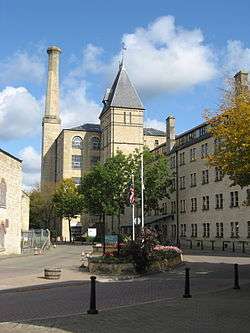Stroud District Council
Stroud District Council is the local authority for Stroud District. Stroud District is located in Central Gloucestershire in the South West of England region. The Council itself is based in the Council Offices in Stroud proper, but the borough also comprises Nailsworth, Dursley, Cam, and Wotton-under-Edge as well as a number of other settlements. It is administratively distinct from Stroud Town Council, which serves the smaller parish of Stroud only.[2]
Stroud District Council | |
|---|---|
 | |
| Type | |
| Type | |
| Structure | |
| Seats | 51 councillors |
 | |
Political groups |
|
| Elections | |
| First past the post | |
Last election | 5 May 2016 |
| Meeting place | |
 | |
| Ebley Mill, Ebley Wharf, Stroud | |
| Website | |
| www | |
Stroud District Council elects 51 Councillors from 27 wards. Following the May 2016 local elections and defections of 2 Labour Councillors (1 directly to the Greens and 1 to Independent (now sits with the renamed Green and Independent Group but is not a Green Party member), a member of the Conservative Group has resigned from Conservatives and now sits as an independent Stroud District Council comprises 21 Conservative Councillors, 16 Labour Councillors, 10 Green and Independent Councillors, 2 Liberal Democrat Councillors, 1 Independent and 1 Independent (Conservative) Councillor.[3]
History
Stroud District Council was formed under the Local Government Act 1972, on 1 April 1974, by a merger of Nailsworth and Stroud urban districts, Dursley Rural District, Stroud Rural District, and parts of Gloucester Rural District, Sodbury Rural District and Thornbury Rural District. In 1991 following a boundary review the Parish of Hillesely and Tresham was transferred from Northavon District Council to Stroud. This area was formerly in the Chipping Sodbury Rural District Council area. At the same review the parish of Quedgeley (formerly in Gloucester Rural) was transferred from Stroud to Gloucester City
The inaugural meeting of the new Council following elections in June 1973 was on 29 June 1973 at Stroud Subscription Rooms.
Responsibilities
Stroud District Council carries out a variety of district council functions including:
- Benefits - Housing and Council Tax
- Car Parking
- Concessionary Travel
- Council Tax - Administration and Collection
- Elections and Electoral Registration
- Environmental Health (includes Domestic and Commercial Premises)
- Food Safety and Hygiene Complaints
- Noise Pollution and Pest Control
- Housing Administration
- Licensing
- Caravan Sites
- Planning, including Planning Applications, Advice and Appeals
- Public Conveniences (in some locales)
- Health and Leisure Centres
- Refuse Collection
- Recycling
- Tourism and Visitor Information.
Notable Members of Stroud District Council (and predecessors)
Margaret Hills (née Robertson) was the first Woman Elected to Stroud Urban District Council in 1928.[4] where she stood as a representative of the Stroud Womens Citizens Association (SWCA). She remained a member until 1936 when the Council was expanded to cover Cainscross and Rodborough.
David Drew (politician) is also a former member of the Council originally representing the Stonehouse Ward and more recently the Paganhill and Farmhill Ward. Tom Levitt is also a former member and served for a short time before moving to High Peak in the early 1990s.
References
- "Stroud - Your Councillors". www.stroud.gov.uk. Retrieved 19 August 2018.
- "Archived copy". Archived from the original on 9 October 2016. Retrieved 6 October 2016.CS1 maint: archived copy as title (link)
- "Archived copy". Archived from the original on 9 October 2016. Retrieved 6 October 2016.CS1 maint: archived copy as title (link)
- Womens Leader (formerly Common Cause) 27 April 1928